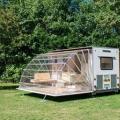A fairy-tale castle, hidden in the forests of the Bavarian Alps, is a real masterpiece that has earned insane popularity among tourists and brings fabulous profits to Germany. Neuschwanstein became the prototype for the Sleeping Beauty Castle at Disneyland Paris, Tchaikovsky's inspiration for the ballet Swan Lake and the embodiment of Ludwig II's love for Wagner's music ...
Author: P_I_F.
Neuschwanstein translates as "New Swan Stone". The entire architecture of the building is permeated with a swan motif. The swan is the heraldic symbol of the ancient family of the Counts of Schwangau, whose successor was Ludwig II's father, Maximilian II of Bavaria. Ludwig was a huge fan of Richard Wagner, identifying himself with one of the characters in his operas - The Swan Knight. Having inherited the royal throne, Ludwig II realized his old fantasy - a swan castle of incomparable beauty.
Myths and facts
Far from the bustling cities, almost at the very border with Austria, construction began in 1869 under the direction of Munich-based theater artist Christian Jank. But due to Ludwig's extravagant tastes and quirks, this process progressed very slowly. For example, 14 carpenters worked only on woodcarving in one bedroom of the king for 4.5 years.
The construction of the castle was stopped when Ludwig was removed from power due to intrigues in his own office. The king rarely dealt with matters of state personally, and with his antics he earned the glory of a madman. In addition, he suffered from hallucinations - for example, he dined with the spirit of Louis XIV. Under Bavarian law, the king can be removed from power if found unfit for government. And after the report of his cabinet in 1886, he was overthrown.
Ludwig was transported to Berg Castle, where he soon drowned in Lake Starnberg. However, regarding this mysterious death, which was considered a suicide at the time, it is suggested that the cabinet was not happy with the simple removal of Ludwig from power. Especially considering that his treating psychiatrist also shared the fate of his patient.
These mysterious events have spawned many legends and created an intriguing halo around Neuschwanstein Castle, making it the most famous castle in Germany.
You can climb to it from the town of Füssen either on foot or by horse.

On the way, you have to admire the views of Lake Alpsee and Hohenschwangau Castle - the headquarters of the parents of the "fairy king".

Here it is close.

Gradually, contours begin to appear in the fog ...

... and then the walls of Neuschwanstein Castle appear - the New Swan Cliff, if we call it.

Since all this was built not so much for show-off, but for the soul, a special observation bridge was also erected in a strategic place at the same time. It is not visible here yet.

But now the wind disperses the fog and the Marienbrücke bridge appears in the distance. It is from here that one of the two best views of the castle opens.

There are always so many people here that it is not so easy to squeeze through. Some push strollers in front of them.
Actually, I was lucky - having settled down behind one family, just equipped with a battering ram, I entered the bridge.

Even in nasty weather, the views here are pretty pretty.

Neuschwanstein Castle stands on the site of two fortresses. King Ludwig II ordered at this place to lower the plateau by about 8 meters by blowing up a rock and thereby create a place for the construction of a "fairytale palace". On September 5, 1869, the foundation stone was laid for the construction of a huge castle.
Construction work in the castle (1882-1885). In 1880, more than 200 carpenters, stone cutters and auxiliary workers were employed at the construction site.

Ludwig II went down in history as a "fairytale king" thanks to the castles he built, on which he spent all his money and time. On June 13, 1886, he drowned on Lake Starnberg under mysterious circumstances. According to one of the widespread versions, it was a political assassination of an inconvenient and uncontrollable king.
After the death of the king in 1886, all construction work was suspended. The main tower of the castle with a church, 90 m high, which was supposed to rise above all buildings, was not built at all.

Neuschwanstein Castle in Bavaria really gives the impression of a fairytale castle. It was built at a time when castles had already lost their defensive functions.

Inside, Neuschwanstein is very different from the Prussian royal castles of Berlin and Potsdam. But it is strictly forbidden to shoot there. The castle is currently a museum. Visiting is possible only as part of a group.

Interior decoration The castle is a mixture of various architectural and artistic styles, a combination of Moorish, Gothic and Baroque elements: there are columns and a throne room. The interior of the large hall in Neuschwanstein Castle:

Although the throne room was not completed during construction, it is without doubt the most impressive. Post card, end of XIX century:

Ludwig's bedroom at Neuschwanstein Castle. Eyewitnesses claimed that 15 craftsmen worked on the manufacture of a carved wooden bed for Ludwig for 4.5 years:

Views from the balcony of Neuschwanstein Castle in Bavaria.

At the end of World War II, part of the Reichsbank's gold was kept in the castle. V the last days During the war, gold was taken away in an unknown direction.

Neuschwanstein Castle in Bavaria primarily impresses with its cold grandeur and pointed towers among the alpine peaks:

Views from the balcony of the castle.

Neuschwanstein Castle in summer:

... and in winter.

Every year over 1.3 million visitors pass through the gates of Neuschwanstein Castle in Bavaria.
We at TravelAsk decided that our life is sorely lacking in fairy tales, magic and majestic beauty. And what could be more fabulous than a magnificent ancient castle, as if descended from the pages of a book? Therefore, today we are introducing you to another portion of the most beautiful and impressive castles on the planet. Well, and a few words about them, of course, we will not forget to tell you!
Chenonceau Castle, France
Has a "popular" name - "Ladies Castle". One of the most beloved, famous and most visited castles in France. It is privately owned but open to the public.
Castel Sant'Angelo, Rome, Italy

Cochem Castle, Germany

It was first documented in 1051.
Dunnottar Castle - a medieval castle on the east coast of Scotland

Edinburgh Castle - an ancient fortress on Castle Rock in the center of the Scottish capital

Hearst Castle ("Hearst Castle"), California, USA

National historical monument on the Pacific coast of California. The house has 56 bedrooms, 61 restrooms, 19 living rooms, the estate has several swimming pools and tennis courts, a cinema, an airfield and the world's largest private zoo (now without animals).
Herstmonceau Castle, built in the 15th century, is located 10 km northeast of Eastbourne. It is the oldest and largest brick building in England.

Hohenwerfen Castle is located in Austria, 155 m above the Salzach valley, 40 km from Salzburg

Hohenzollern Castle - an ancient castle-fortress in Baden-Württemberg, Germany

The medieval castle fortress was first mentioned in 1267, but it is assumed that it was built earlier, in the 11th century.

The castle is located 855 m above sea level on a detached mountain called the Hohenzollern. Among local population this mountain is better known as Zollenberg or simply Zoller.

Today the castle is a popular tourist attraction.
Lichtenstein Castle - "fairytale castle" of the 19th century in the town of Honau, in the commune of Lichtenstein in Baden-Württemberg

Located at an altitude of 817 m. Today the castle is open to visitors. It houses a large collection of historical weapons and armor.
Matsumoto Castle - an ancient Japanese castle in the city of Matsumoto, Nagano Prefecture

Monastery of Pantanassa, Mystra, Greece

Pena Palace - a palace in Portugal, located on a high cliff above Sintra and featuring a fantastic pseudo-medieval style

The entire composition of the mountain, the castle and the adjacent 270 hectare park is one of the earliest examples of romantic landscape architecture of the 19th century. The castle and park originated in 1840 as a summer royal residence on the site of a small abandoned monastery.
Quinta da Regaleira, Portugal

The palace and park complex, on the territory of which there is a romantic palace in the neo-Gothic style, a chapel and a park with lakes, grottoes, fountains and various architectural whims

It is named after the Baroness Regaleira, who acquired the estate in 1840, and is also known as the palace of the millionaire Monteiro.
Mehrangarh Fortress, Jodhpur, India

Mont Saint Michel, France

Cité or Carcassonne fortress is a medieval architectural ensemble located in the French city of Carcassonne in the department of Aude

Moritzburg Castle, Germany

Alhambra ("Red Castle") - an architectural and park ensemble located on a hilly terrace in the eastern part of the city of Granada in southern Spain

Trakai Island Castle - the largest surviving ancient castle in Lithuania

Wischering Castle, Lüdinghausen, Germany

Fernichurst Fortress in Scotland

Ninomaru Castle, Japan

Incredible in their beauty architectural relics were left to us by history, which you can admire for a long time, because they keep so much in themselves. These castles are located in beautiful and unusual places for example on top of mountains or on the water, which add even more charm to them. If castles could speak, they could tell us a lot, a lot ..
Howard Castle, Yorkshire
One of the grandest mansions in Britain, this beautiful castle has been home to the Howard family for over 300 years.
Hohenschwangau Castle, Germany

It was built in the 19th century in Germany and is visited by over 300,000 tourists a year.
Corfe Castle, Dorset

Corfe Castle is a fortress that was built in the 11th century by William the Conqueror.
Malbork Castle, Poland

Malbork is the largest castle in the world (by area) and the largest brick house in Europe.
Neuschwanstein Castle, Germany

Ludwig II of Bavaria built this castle as a personal refuge. After he died in 1886, Neuschwanstein Castle became open to visitors because with the help of tourists it was possible to raise money for its maintenance. Since then, there have been over 60 million visitors a year visiting this castle.
Chambord Castle, France

This palace was built as a hunting lodge for Francis I, and is very clear. French. Renaissance architecture. It has been open to visitors since 2007 and attracts over 700,000 visitors a year.
Osaka castle, Japan

One of the most famous castles in Japan, Osaka. It was built on top of a high hill in the 16th century to protect its inhabitants from enemies.
Hohenwerfen castle, Austria

The castle was built in the 11th century and is located in part of Bavaria in the place of Berchtesgaden and was built on the Tennengebirg mountain. The exterior of this castle was used as a French hotel in the film Newlyweds.
Kilkenny Castle, Ireland

Kilkenny was built in 1195 by William Marshal. Now serves as conferences for diplomatic negotiations.
Peles Castle, Romania

This castle was built in the architectural direction of the neo-renaissance. The castle is located in the Carpathians, built between 1873 and 1914.
Moritzburg Castle, Germany

Named after Duke Moritz of Saxony, this palace sits on man-made land and is surrounded by forests that were used for hunting.
Castillo de Coca, Spain

This castle was built on the site of ancient Cauca, the birthplace of the Roman emperor Theodosius. The castle now serves as an educational institution for foresters.
Sleeping Beauty Castle at Disneyland, California

Sleeping Beauty Castle was inspired by the castle that we wrote about above Neuschwanstein and serves as a landmark in Disneyland
Kronborg Castle, Denmark

Built in the 1420s, Kronborg is one of the most important fortifications in Northern Europe. It was immortalized as Elsinore in William Shakespeare's Hamlet.
Alnwick Castle, Northumberland (England)

The exterior of Alnwick Castle was used in the Harry Potter movie and was the prototype for Hogwarts Castle and has approximately 800,000 visitors a year.
Edinburgh Castle, Scotland

Perched on volcanic rock, this 12th century palace has become a recognizable symbol of Edinburgh.
Highclere Castle, UK

A 19th-century castle that serves as the main filming location for the hit TV series Downton Abbey.
Chateau de Versailles, France

This royal castle in France has a whopping 2,300 rooms, 67 staircases, and 5,210 pieces of furniture.
Prague Castle, Czech Republic

Prague Castle was named the largest and oldest castle in the world in the Guinness Book of Records, occupying 70,000 square meters.
Kylemore Abbey, Ireland

Kylemore was built as a private residence for London's wealthy physician, Mitchell Henry. But he was forced to sell it in 1909 due to gambling debts.
Bodiam Castle, UK

A 14th century castle surrounded by a moat was built by Sir Edward Dalingrigg to protect the area from French invasion during the Hundred Years War.
Hochosterwitz Castle, Austria

One of the most impressive medieval castles in Austria, Gochosterwitz is 160 meters high and can be seen 30 km away on a clear day.
Chillon Castle, Switzerland

This island castle is made up of 100 separate buildings that are combined into a palace.
Catherine Palace, Russia

The construction of the residence of Catherine I was laid in 1717 and was built for the rest of the empress. In 1752 it was rebuilt.
Windsor Castle, England

This 11th century castle was a royal residence and is the longest fortress in Europe.
Hogwarts Universal Studios, Orlando

The main building of the wildly successful Harry Potter movie. Hogwarts was brought to life at the Universe Studios (Universal) in Orlando, Florida.
Balmoral Castle, UK

Balmoral has been the seat of the British royal family since 1852, when it was acquired by Victoria and her husband, Prince Albert.
Conwy Castle, North Wales

This medieval fortress was built by Edward I in 1283 and costs approximately £ 15,000.
Schwerin Castle, Germany

The first reports of this castle date back to 973, and currently serves as the seat of the state parliament.
Neuschwanstein is a fantasy come true, a fairytale castle that lifted its like toy turrets and galleries over the wooded hills in the Bavarian Alps near the city of Füssen near the Austrian border.
It gives the impression of a theatrical scenery, and in part it is, as it was created under the active leadership of the Munich theater artist Christian Jank. At the same time, the castle is very impressive in size, and it took seventeen years to build. Ludwig grew up in the nearby Hohenschwangau castle. This building, stylized as a medieval fortress, was built by his father Maximilian II. Ludwig was a passionate admirer of Germanic mythology and, apparently, identified himself with the swan knight Lohengrin. Having attended the premiere of the opera of the same name by Richard Wagner in 1858, he was overjoyed. When, three years later, at the age of eighteen, Ludwig inherited the royal throne, one of his first acts of state was to invite the composer to Munich.

Now, possessing money and power, he became a patron of Wagner, paid all debts for the composer and promised to establish a festival to perform Wagner's works. In his operas, Wagner brought the world of German legends and tales onto the stage on a large scale, trying to captivate the audience with the drama of the eternal confrontation between Good and Evil. Ludwig, meanwhile, ordered the construction of a fairytale castle, which in all respects would correspond to the ideals of the ancient Germanic knighthood.

This, as well as his other decisions, more and more inclined those around him to think that the king was damaged in his reason and, as a ruler, was not able to look at things sanely. When Ludwig was still young, Bismarck publicly announced that he was quite sane, although even then many strangeness of his behavior, his manner of fancy dressing, his whole lifestyle in general, he, for example, sometimes slept all day, and sometimes invited to yourself for dinner .. the spirit of Louis XIV. But at the end of his life, his madness was quite obvious and no one doubted it.
Eyewitnesses and contemporaries claimed that fifteen master carvers worked on the manufacture of a carved wooden bed for Ludwig for four and a half years. The interior of the castle is a mixture of various architectural and artistic styles, a combination of Moorish, Gothic and Baroque elements: here are stalactite columns, a throne room in the decadent-Byzantine spirit, and a singing hall with exquisite lighting, intended for staging Wagnerian operas.





Have you ever been to medieval castles? They say that almost any fortress that has survived to this day has long been a haven for real ghosts. Of course, rational thinking tells us that we should not be afraid of these tales - but what about the facts that prove the real existence of paranormal activity?
Medieval Europe was not the most pleasant place to live. Here the cult of a seigneur reigned, capable of sending peasants to death for the slightest offense. The times of the witch hunt left a wide clearing in the female population of half the continent, and the bones of the so-called sorcerers are still found embedded in the walls of medieval castles. Before you are a dozen of such fortresses, which even locals try to bypass.

Germany
It is believed that a whole horde of ghosts has lived here for five centuries. Approximately at early XVI For centuries, the owner of the castle hired a couple of farmers to deal with his unfaithful wife. Soon after, both the man and his sons died in their own beds. Since then, the castle has been considered cursed.
Lip castle

Ireland
In the XII century, the castle was built by the influential O'Bannon clan. The family nest of the eminent Irish very soon turned into a scarecrow for the whole area: fratricidal feasts, constant executions and even sacrifices took place here. The local chapel received the nickname "Blood Chapel" after a jealous husband stabbed his wife and lover in it, and then brought the children there and made them pray for seven days over the rotting bodies of adulterers. Are there ghosts here? Still would!
Zvikov

Czech
It is one of the most important and significant Gothic castles in medieval Bohemia. According to rumors, a local Zvikovsky devil lives in the castle, who does not like people very much. Jokes aside, but strange, unpleasant things actually happen here. Animals refuse to enter some rooms of the castle, sometimes the curtains in the main hall light up spontaneously, and those who sleep in the main tower die within a year. That's what the locals say.
Moosham

Austria
Built at the end of the 12th century, Moosham Castle has become a silent witness to the death of thousands of young girls. The times of the witch hunt turned Moosham into a real stronghold of the Inquisition, blood flowed like a river for the glory of the papal throne and Christian virtues. Much later, in the 19th century, the remains of dead deer and livestock began to be found near the castle, which gave rise to new wave rumors. To this day, it is believed that a clan of ancient werewolves lives in the basements of Moosham, who go hunting at night.
Bran Castle
Romania
One of the most terrifying castles in the world, Bran Castle was the seat of Vlad III, a brutal Romanian ruler better known as Vlad Dracula or Vlad Tepes. It was this man who inspired Bram Stoker to write the famous Gothic novel "Dracula": you can imagine how gloomy the atmosphere in the ancestral nest of the world's main vampire is. A little more creepiness? Easily. In one of Bran's main halls there is a golden chest where the heart of Queen Mary is hidden. Naturally, it is still beating - if the rumors are to be believed.
Chateau de Brissac

France
Built in the 11th century, the Brissac castle is considered home to all the ghosts and ghosts of the west-central part of France. According to legend, one of the first owners of the castle caught his wife with another man and killed both of them. Today, the new owners arrange receptions here for high society from among those who want to tickle their nerves.
Fraser Castle

Scotland
Located in the eastern part of Scotland, Fraser Castle is famous for the gruesome story of a princess killed in a dream by demons. They say that the body of the unfortunate woman was dragged down the stone steps of the tower, and the servants could not wash the blood after that. The owners allegedly had to sheathe the steps with wooden panels, but on a full moon, blood still appears through them.
Horst

Belgium
The dilapidated castle Horst is inhabited to this day. True, not people live here, but real ghosts. At least that's what the locals say. They also say that the ghost of the former owner of the castle returns every full moon in a wagon drawn by six pitch-black horses.
Predjama Castle

Slovenia
The famous pirate knight Erazem once lived here, who organized raids on the coast and passing ships. The castle is riddled with hundreds underground passages, caves and hideouts that certified demon hunters do not dare to explore.
Dragsholm

Denmark
One of the scariest places in Denmark. The famous White Lady lives here - the ghost of a young girl who fell in love with a local commoner. The father walled up his own daughter in the room where she ended her days. It sounds like an ordinary legend, but there is a place for the truth. At the beginning of this century, shocked builders working to restore part of the walls discovered a secret room where a skeleton in a white wedding dress sat at a table.




